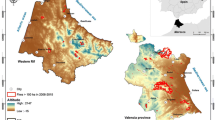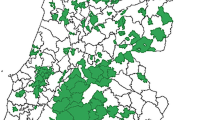Abstract
Every year fires cause several problems and considerable damage to the Portuguese socioeconomic context and to forest resources and activities, despite the significant financial support, from national and European Union budgets, towards prevention. This is an annual scourge that requires multidisciplinary analysis to aid in the design of adjusted firefighting strategies. In this framework, the objective of the study presented here is to investigate if there are Portuguese regions where the incidences of fire, in terms of number of fires and burnt area, are similar, helping toward the creation of firefighting policies in cooperation with neighbouring municipalities. On the other hand, there is a need to understand the interactions of these contexts between the environment and human ecology and finally find municipalities that may be considered as a benchmark for others around them. For this, data from the Statistics Portugal (INE in Several statistics and informations, 2015. https://www.ine.pt/xportal/xmain?xpid=INE&xpgid=ine_base_dados), for the period 2000–2013, was used and analyzed through descriptive and cross-section techniques and data envelopment analysis (DEA) for the municipalities of Continental Portugal. For the cross-section analysis, the GeoDa (Software. GeoDa Center for Geospatial Analysis and Computation, 2015) software was used considering spatial autocorrelation methodologies and for the DEA the DEAP (DEAP V2.1—a data envelopment analysis (computer) program, 2017. http://www.uq.edu.au/economics/cepa/deap.php) program. The results show that there is spatial autocorrelation across Portuguese municipalities, in the period considered, for the variables considered, which allows for the definition of “regions of similar incidence” for which similar policies can be designed, namely those promoting cooperation among neighbouring municipalities. In turn, some municipalities may be considered as benchmarks inside zones of similar incidence.









Similar content being viewed by others
References
Alexandridis TK, Gitas IZ, Silleos NG (2008) An estimation of the optimum temporal resolution for monitoring vegetation condition on a nationwide scale using MODIS/Terra data. Int J Remote Sens 29(12):3589–3607
Coelli TJ (1996) A guide to DEAP version 2.1: a data envelopment analysis (computer) program. In: CEPA working papers, 96/08, centre for efficiency and productivity analysis, Australia
Crecente-Campo F, Pommerening A, Rodríguez-Soalleiro R (2009) Impacts of thinning on structure, growth and risk of crown fire in a Pinus sylvestris L. plantation in northern Spain. For Ecol Manag 257:1945–1954
DEAP (2017) DEAP V2.1—a data envelopment analysis (computer) program. http://www.uq.edu.au/economics/cepa/deap.php
GeoDa (2015) Software. GeoDa center for geospatial analysis and computation
Gil-Tena A, Brotons L, Saura S (2009) Mediterranean forest dynamics and forest bird distribution changes in the late 20th century. Glob Change Biol 15:474–485
Gutiérrez E, Lozano S (2013) Avoidable damage assessment of forest fires in European countries: an efficient frontier approach. Eur J For Res 132:9–21
ICNF (2017) 9° Relatório Provisório de Incêndios Florestais—2017: 01 de Janeiro a 16 de Outubro. RIF09/2017, Departamento de Gestão de Áreas Públicas e de Proteção Florestal, ICNF—Sistema de Gestão de Informação de Incêndios Florestais
INE (2015) Several statistics and informations. https://www.ine.pt/xportal/xmain?xpid=INE&xpgid=ine_base_dados
INE (2017) Several statistics. https://www.ine.pt/xportal/xmain?xpid=INE&xpgid=ine_base_dados
Kim D, Arthur MA (2014) Changes in community structure and species–landform relationship after repeated fire disturbance in an oak-dominated temperate forest. Ecol Res 29:661–671
Landis AG, Bailey JD (2005) Reconstruction of age structure and spatial arrangement of pinon–juniper woodlands and savannas of Anderson Mesa, northern Arizona. For Ecol Manag 204:221–236
Liberato MLR, Ramos AM, Gouveia CM, Sousa P, Russo A, Trigo RM, Santo FE (2017) Exceptionally extreme drought in Madeira Archipelago in 2012: vegetation impacts and driving conditions. Agric For Meteorol 232:195–209
Lilleskov EA, Bruns TD, Horton TR, Taylor DL, Grogan P (2004) Detection of forest stand-level spatial structure in ectomycorrhizal fungal communities. FEMS Microbiol Ecol 49:319–332
Lloret F, Estevan H, Vayreda J, Terradas J (2005) Fire regenerative syndromes of forest woody species across fire and climatic gradients. Oecologia 146:461–468
Martínez-Fernández J, Chuvieco E, Koutsias N (2013) Modelling long-term fire occurrence factors in Spain by accounting for local variations with geographically weighted regression. Nat Hazards Earth Syst Sci 13:311–327
Martinho VJPD (2015a) Output impacts of the single payment scheme in Portugal: a regression with spatial effects. Outlook Agric 44:2
Martinho VJPD (ed) (2015b) The agricultural economics of the 21st century. Springer, Berlin
Martinho VJPD (2016) Forestry activity in Portugal within the context of the European Union: a cluster in agricultural economics for sustainable development. Environ Dev Sustain 18(5):1339–1397
Mourão PR, Martinho VD (2014) The choices of the fire—debating Socioeconomic determinants of the fires observed in Portuguese municipalities. For Pol Econ 43:29–40
Mourão PR, Martinho VD (2016) Discussing structural breaks in the Portuguese regulation on forest fires—an economic approach. Land Use Pol 54:460–478
Murphy BP, Paron P, Prior LD, Boggs GS, Franklin DC, Bowman DMJS (2010) Using generalized autoregressive error models to understand fire–vegetation–soil feedbacks in a mulga–spinifex landscape mosaic. J Biogeogr 37:2169–2182
Nowicki P, Marczyk J, Kajzer-Bonk J (2015) Metapopulations of endangered Maculinea butterflies are resilient to large-scale fire. Ecohydrology 8:398–405
Nunes AN, Lourenço L (2017) Increased vulnerability to wildfires and post fire hydro-geomorphic processes in Portuguese mountain regions: what has changed? Open Agric 2:70–82
Özden A (2016) Measuring environmental efficiency in the eu agricultural sector “considering desirable and undesirable outputs”. Fresenius Environ Bull 25(1):240–248
Pausas JG (2006) Simulating mediterranean landscape pattern and vegetation dynamics under different fire regimes. Plant Ecol 187:249–259
Pearson DM (2002) The application of local measures of spatial autocorrelation for describing pattern in north Australian landscapes. J Environ Manag 64:85–95
Pons P, Bas JM (2005) Open-habitat birds in recently burned areas: the role of the fire extent and species’ habitat breadth. Ardeola 52(1):119–131
Ruffault J, Curt T, Martin-StPaul NK, Moron V, Trigo RM (2018) Extreme wildfire events are linked to global-change-type droughts in the northern Mediterranean. Nat Hazards Earth Syst Sci 18:847–856
Sousa AMO, Pereira JMC, Silva JMN (2003) Evaluating the performance of multitemporal image compositing algorithms for burned area analysis. Int J Remote Sens 24(6):1219–1236
Tng DYP, Murphy BP, Weber E, Sanders G, Williamson GJ, Kemp J, Bowman DMJS (2011) Humid tropical rain forest has expanded into eucalypt forest and savanna over the last 50 years. Ecol Evol 2(1):34–45
Viegas DX, Almeida MF, Ribeiro LM, Raposo J, Viegas MT, Oliveira R, Alves D, Pinto C, Jorge H, Rodrigues A, Lucas D, Lopes S, Silva LF (2017) O complexo de incêndios de Pedrógão Grande e concelhos limítrofes, iniciado a 17 de junho de 2017. Centro de Estudos sobre Incêndios Florestais, ADAI/LAETA, Departamento de Engenharia Mecânica, Faculdade de Ciências e Tecnologia, Universidade de Coimbra
Wang Z, Ma R, Li S (2013) Assessing area-specific relative risks from large forest fire size in Canada. Environ Ecol Stat 20:285–296
Williamson GJ, Murphy BP, Bowman DMJS (2014) Cattle grazing does not reduce fire severity in eucalypt forests and woodlands of the Australian Alps. Austral Ecol 39:462–468
Author information
Authors and Affiliations
Corresponding author
Additional information
Handling editor: Bryan F. J. Manly.
I would like to thank the pertinent comments of the anonymous reviewers.
Rights and permissions
About this article
Cite this article
Martinho, V.J.P.D. Forest fires across Portuguese municipalities: zones of similar incidence, interactions and benchmarks. Environ Ecol Stat 25, 405–428 (2018). https://doi.org/10.1007/s10651-018-0411-9
Received:
Revised:
Published:
Issue Date:
DOI: https://doi.org/10.1007/s10651-018-0411-9




